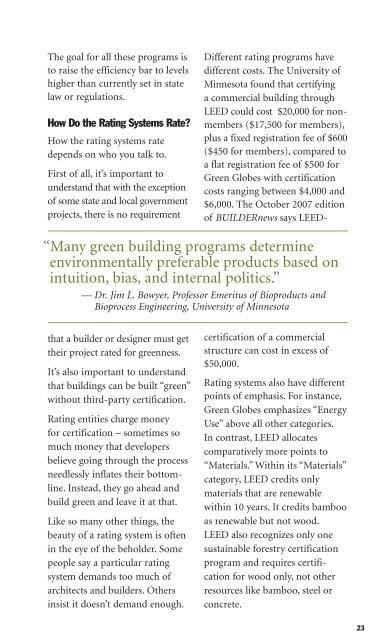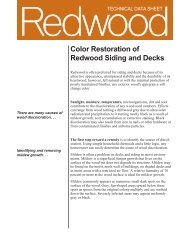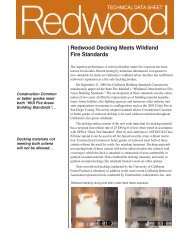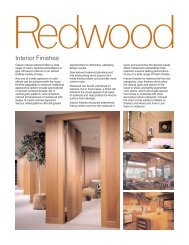The Wood User's Guide to Green Building - California Redwood ...
The Wood User's Guide to Green Building - California Redwood ...
The Wood User's Guide to Green Building - California Redwood ...
Create successful ePaper yourself
Turn your PDF publications into a flip-book with our unique Google optimized e-Paper software.
<strong>The</strong> goal for all these programs is<strong>to</strong> raise the efficiency bar <strong>to</strong> levelshigher than currently set in statelaw or regulations.How Do the Rating Systems Rate?How the rating systems ratedepends on who you talk <strong>to</strong>.First of all, it’s important <strong>to</strong>understand that with the exceptionof some state and local governmentprojects, there is no requirement“Many green building programs determineenvironmentally preferable products based onintuition, bias, and internal politics.”— Dr. Jim L. Bowyer, Professor Emeritus of Bioproducts andBioprocess Engineering, University of Minnesotathat a builder or designer must gettheir project rated for greenness.It’s also important <strong>to</strong> understandthat buildings can be built “green”without third-party certification.Rating entities charge moneyfor certification – sometimes somuch money that developersbelieve going through the processneedlessly inflates their bot<strong>to</strong>mline.Instead, they go ahead andbuild green and leave it at that.Like so many other things, thebeauty of a rating system is oftenin the eye of the beholder. Somepeople say a particular ratingsystem demands <strong>to</strong>o much ofarchitects and builders. Othersinsist it doesn’t demand enough.Different rating programs havedifferent costs. <strong>The</strong> University ofMinnesota found that certifyinga commercial building throughLEED could cost $20,000 for nonmembers($17,500 for members),plus a fixed registration fee of $600($450 for members), compared <strong>to</strong>a flat registration fee of $500 for<strong>Green</strong> Globes with certificationcosts ranging between $4,000 and$6,000. <strong>The</strong> Oc<strong>to</strong>ber 2007 editionof BUILDERnews says LEEDcertificationof a commercialstructure can cost in excess of$50,000.Rating systems also have differentpoints of emphasis. For instance,<strong>Green</strong> Globes emphasizes “EnergyUse” above all other categories.In contrast, LEED allocatescomparatively more points <strong>to</strong>“Materials.” Within its “Materials”category, LEED credits onlymaterials that are renewablewithin 10 years. It credits bambooas renewable but not wood.LEED also recognizes only onesustainable forestry certificationprogram and requires certificationfor wood only, not otherresources like bamboo, steel orconcrete.23





